Evaluation of the Distress Thermometer in older patients with cancer
IF 3
3区 医学
Q3 GERIATRICS & GERONTOLOGY
引用次数: 0
Abstract
Introduction
The Geriatric Depression Scale is a useful tool in screening for depression in older adults, a particularly vulnerable population in oncology. The National Comprehensive Cancer Network (NCCN) Distress Thermometer (DT) has been validated as a fast and effective screening tool for psychological distress in general oncology populations, and it could possibly be used as a surrogate for the longer Geriatric Depression Scale (GDS) test in older adults with cancer.
Materials and Methods
In this retrospective cross-sectional study in older adults prior to starting cancer treatment, we evaluated the relationship between the DT and GDS by comparing 242 older adults with cancers' DT scores to their GDS scores, used receiver operating characteristic analysis to determine a DT cutoff score, and used logistic regression to identify variables associated with higher distress.
Results
The Spearman correlation coefficient between GDS and DT was 0.41, p < 0.001. A cutoff score of 4 was found to be most sensitive and specific (0.66,0.68) for predicting a positive GDS (c-index = 0.70).
Discussion
These results indicate the potential utility of the DT as a mildly to moderately effective screening tool for depression in older adults with cancer starting treatment and support the current NCCN cutoff guidelines to indicate the need for additional distress interventions.
焦虑温度计在老年癌症患者中的评价
老年抑郁症量表是筛查老年人抑郁症的有用工具,老年人是肿瘤学中特别脆弱的人群。国家综合癌症网络(NCCN)焦虑温度计(DT)已被证实是一种快速有效的筛查普通肿瘤人群心理困扰的工具,它可能被用作替代老年癌症患者的老年抑郁量表(GDS)测试。材料和方法在这项对开始癌症治疗前的老年人进行的回顾性横断面研究中,我们通过比较242名患有癌症的老年人的DT评分和GDS评分来评估DT和GDS之间的关系,使用受试者操作特征分析来确定DT截止评分,并使用逻辑回归来确定与较高痛苦相关的变量。结果GDS与DT的Spearman相关系数为0.41,p <;0.001. 预测GDS阳性(c-index = 0.70)的临界值为4分是最敏感和特异的(0.66,0.68)。这些结果表明,DT作为一种轻度到中度有效的筛查工具,在癌症开始治疗的老年人中具有潜在的效用,并支持当前的NCCN截止指南,表明需要额外的痛苦干预。
本文章由计算机程序翻译,如有差异,请以英文原文为准。
求助全文
约1分钟内获得全文
求助全文
来源期刊

Journal of geriatric oncology
ONCOLOGY-GERIATRICS & GERONTOLOGY
CiteScore
5.30
自引率
10.00%
发文量
379
审稿时长
80 days
期刊介绍:
The Journal of Geriatric Oncology is an international, multidisciplinary journal which is focused on advancing research in the treatment and survivorship issues of older adults with cancer, as well as literature relevant to education and policy development in geriatric oncology.
The journal welcomes the submission of manuscripts in the following categories:
• Original research articles
• Review articles
• Clinical trials
• Education and training articles
• Short communications
• Perspectives
• Meeting reports
• Letters to the Editor.
 求助内容:
求助内容: 应助结果提醒方式:
应助结果提醒方式:


